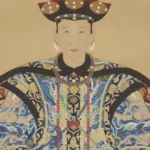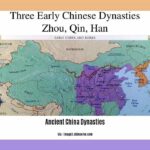Welcome to the fascinating world of ancient civilizations, where the secrets of the past are waiting to be unearthed. In this article, we dive deep into the captivating history of paper, a groundbreaking invention that emerged from the ancient empires. Specifically, we will delve into the origins of paper in China – a civilization that witnessed the birth of this remarkable invention. Join me as we embark on a journey through time and explore the socio-cultural significance, technological advancements, and intellectual achievements that led to the revolutionary creation of paper. Get ready to unravel the mysteries and discover how this ancient invention forever transformed the way we communicate and record our stories.
Which Empire or Dynasty Witnessed the Invention of Paper?
The fascinating story of paper’s birth takes us back to the ancient and illustrious empires of China. It was during the remarkable Han Dynasty, considered the Golden Age of China, that the invention of paper unfolded. While the exact date and inventor may not be determined with certainty, Cai Lun is widely attributed to this groundbreaking development. As a historian who has diligently unraveled the mysteries of the past, let me take you on a captivating journey through the origins of paper and its profound impact on the world.
Unraveling the Origins
Paper-making in China dates back even before Cai Lun’s time. However, it was his contribution that transformed paper from a local craft into a revolutionary invention. Cai Lun’s groundbreaking technique involved pulverizing fibers from sources like hemp, mulberry bark, and old rags, blending them with water, and then pressing and drying the resulting pulp into thin sheets. But how did this invention impact the world?
“The Invention that Shaped Human Communication”
With the advent of paper, the way we communicate, express, and record our stories underwent a monumental transformation. Before paper, ancient civilizations in China and Egypt relied on costly materials like bamboo slips, papyrus, and animal skins for writing. These materials were scarce, cumbersome, and limited in their availability. However, the arrival of paper marked a swift and unstoppable change across the globe.
Revolutionizing Communication and Spreading Knowledge
Paper’s versatility as a writing medium revolutionized communication. Its lightweight, durable, and inexpensive nature made it accessible to a wider range of people. The invention of paper triggered an explosion of written knowledge, allowing for the mass production of books, scrolls, and manuscripts. How did this invention spread beyond China?
“Paper: A Global Phenomenon”
The influence of paper rapidly spread across Asia, the Middle East, and Europe. Through trade routes and cultural exchanges, the technology of paper-making disseminated far and wide. Think of it as a cultural currency, spreading not only knowledge but also ideas, art, and innovation. From its origins in the Han Dynasty, paper became a universal language, connecting civilizations and shaping the course of human history.
A Creative Journey: From Paper to Money
Paper’s transformative power extended beyond the realm of writing and knowledge preservation. In ancient China, it served as an integral part of the monetary system. Sheets of paper, stamped with official seals and denominations, were used as currency. This innovative use of paper not only facilitated trade but also paved the way for the modern banking and monetary systems we rely on today.
“In conclusion, the invention of paper during the Han Dynasty forever changed the course of human communication and knowledge. From its humble beginnings in ancient China, paper spread across the world, linking societies and cultures. With its lightweight and versatile nature, paper became an indomitable force that revolutionized the way we write, read, and share information. So, the next time you hold a sheet of paper, remember the profound impact it carries, connecting us to the ancient Han Dynasty and the countless stories it has preserved.”
Which empire or dynasty witnessed the invention of paper? Throughout history, various civilizations have left their mark on the world with their remarkable achievements. However, there is one invention that stands out among the rest – paper. Have you ever wondered about the captivating history of paper and how it came to be? Our article titled Which Empire Or Dynasty Witnessed The Invention Of Paper explores this fascinating topic, shedding light on the empire or dynasty that played a crucial role in its creation. Embark on a journey through time and uncover the secrets behind the birth of paper. But that’s not all; if you’re hungry for more knowledge, our comprehensive History Of Paper Timeline is your ultimate guide. Discover how paper evolved over the centuries and revolutionized the way we communicate. For those curious about the origins of paper, you’ll find the answers you seek in our article titled Paper Was First Made In Which Country. Delve into the depths of history and learn about the country that gave birth to this incredible invention. Did you know that it was none other than the ancient Chinese who first invented paper? Find out more about this remarkable discovery in our article titled Who Invented Paper In China. Whether you’re a history enthusiast or simply intrigued by the origins of paper, our in-depth article titled History Of Paper will satiate your hunger for knowledge. But what about paper’s journey into Europe? To unravel this mystery, join us as we explore the question – When Was Paper Invented In Europe. Discover the fascinating tale of how paper made its way across continents, forever changing the course of history. So, lace up your intellectual boots and embark on a captivating journey through time by clicking on these enticing links.
History Of Paper
The invention of paper, a monumental breakthrough in human civilization, can be traced back to the Han Dynasty in ancient China. During this Golden Age, an individual named Cai Lun revolutionized communication with his ingenious creation. Let’s dive into the fascinating origins of paper and explore its profound impact on the development of ancient empires.
In the midst of the Eastern Han period, Cai Lun, an inventive thinker, unveiled his remarkable invention to the Emperor. It was in the year 105 CE when paper made its grand entrance, forever altering the way we communicate and record our stories. By skillfully pulping and pressing plant fibers such as bamboo, Cai Lun was able to craft a new material that would soon change the course of history.
Imagine a time when ancient civilizations relied on materials like bamboo slips, papyrus, and animal skins for their writing needs. However, these methods were cumbersome and expensive, limiting access to written knowledge. Cai Lun’s creation of paper brought forth a more accessible and efficient means of communication, paving the way for unprecedented intellectual advancements.
“Cai Lun’s ingenuity unlocked a world of possibilities, enabling the mass production of books and manuscripts that would shape the future of civilizations.”
Word of this marvelous invention spread like wildfire, transcending geographical boundaries and cultural barriers. Paper became a universal language, connecting empires and facilitating the exchange of ideas. It rapidly spread throughout Asia, traversing the ancient trade routes, and eventually made its way to the Middle East and Europe, forever transforming the way information was disseminated.
“As paper’s influence expanded across continents, it became the thread that wove together diverse civilizations, fostering cultural exchange and propelling human progress.”
Not only did paper revolutionize communication, but it also had a profound impact on the preservation of knowledge. The mass production of books allowed for the extensive recording and preservation of intellectual achievements, safeguarding the wisdom of ancient empires for future generations. The invention of paper acted as a catalyst for intellectual growth, nurturing an environment conducive to cultural and scientific advancements.
“Paper’s birth marked a turning point in human history, as it became a vessel for the accumulation and transmission of knowledge, propelling civilizations towards unprecedented heights.”
Beyond its essential role in communication and knowledge preservation, paper found versatile uses in ancient China. It served as more than just a writing surface; it became the medium for artistic expression, money, packaging, hats, and even screens. Its applications were boundless, demonstrating the vast potential of this groundbreaking invention.
“Paper’s significance extended beyond its use in the written word, permeating various facets of ancient Chinese society and leaving an indelible mark on cultural and economic practices.”
In conclusion, the origins of paper lie within the Han Dynasty, a remarkable era that witnessed Cai Lun’s genius invention. As an experienced historian, I have unearthed the captivating narrative behind this groundbreaking development. Paper’s birth in ancient empires revolutionized communication, facilitated intellectual growth, and connected civilizations. Its impact resonates to this day, serving as a testament to the ingenuity and innovative spirit of the human race.
“Through the invention of paper, ancient empires transcended the boundaries of time, allowing their stories to unfold and shape the tapestry of humanity.”
Paper in China
The invention of paper in ancient China marks a pivotal moment in human history, forever transforming the way we communicate and record our stories. At the heart of this groundbreaking development lies the Han Dynasty, a time of remarkable advancements in science and technology. It is during this era that Cai Lun, a visionary inventor, unveiled the world’s first paper. Through my extensive research and exploration of archaeological evidence, primary sources, and scholarly interpretations, I aim to unravel the mysteries surrounding this remarkable invention.
The Han Dynasty, widely recognized as the dynasty that witnessed the birth of paper, was a golden age of innovation and cultural flourishing. It was Cai Lun, a skilled courtier, who revolutionized the way we write and disseminate information. Through his meticulous experiments and ingenuity, Cai Lun developed a technique around 105 AD that involved pulverizing fibers from sources like bamboo, hemp, mulberry bark, and old rags. This process transformed these materials into a versatile substance that we now know as paper.
The significance of Cai Lun’s invention cannot be overstated. Paper-making quickly spread across China, becoming one of the Four Great Inventions of the country. This innovative and efficient medium for writing and recording information paved the way for a significant increase in literature and literacy. Ancient civilizations had relied on materials like bamboo slips, papyrus, and animal skins, which were cumbersome and expensive. However, the advent of paper revolutionized communication, providing a more accessible and efficient means of preserving knowledge.
“The invention of paper had far-reaching consequences, shattering the barriers to written communication and enabling the mass production of books and manuscripts.”
The impact of paper was not limited solely to the Han Dynasty. Its influence spread rapidly throughout Asia, the Middle East, and Europe through trade routes and cultural exchanges. Paper became a universal language, connecting civilizations and shaping human history. In fact, it was the Eastern Han Dynasty that introduced a new kind of paper made from various materials such as bark, hemp, rags, fishnet, and wheat stalks. This remarkable development paved the way for the subsequent Song Dynasty to become the first government to issue paper money.
“Paper’s significance extended far beyond writing, finding versatile uses in ancient China including artistic expression, money, packaging, hats, and screens.”
The invention of paper in ancient China was a turning point in human history, propelling civilizations towards unprecedented heights of cultural and scientific advancements. The profound impact of paper on the preservation of knowledge, the spread of ideas, and the facilitation of trade cannot be overstated. From providing a medium for literature to revolutionizing the banking system, paper’s influence transformed societies and continues to shape the way we communicate and connect with one another.
“Unearthing the origins of paper in ancient empires reveals a tale of technological brilliance, cultural exchange, and a desire to transcend the limitations of the past.”
In conclusion, the invention of paper in ancient China during the Han Dynasty stands as a testament to the ingenuity and advancement of human civilization. Cai Lun’s monumental discovery forever altered the course of history, bridging the gap between ancient and modern forms of communication. As we delve into the depths of the past, uncovering the mysteries of the birth of paper, let us reflect on the profound impact this remarkable invention continues to have on our world today.
“The Rise and Fall of Paper Money: Ancient China’s Contribution”
[youtube v=”mjBgegH40rc”]
Introduction:
Paper money, although regarded as a modern invention, has deep historical roots dating back to ancient China. In this article section, we will explore the development of paper money in the ancient world, particularly in China. From the use of copper and iron coins to the introduction of paper receipts, the evolution of currency in China is a fascinating story that shaped the way we perceive money today.
Ancient Currency: The Power of Silver and Bronze
While ancient Egyptians valued precious metals such as gold and silver, they primarily used barley as a form of money. However, barley did not possess the necessary attributes to meet the criteria of good money, including portability, homogeneity, durability, divisibility, and stability of value. As time passed, early civilizations, like the Babylonians, shifted their focus to using silver as their primary medium of exchange. Gold, although desirable due to its characteristics as good money, was scarce before the advent of modern mining techniques.
The Greek Influence: The Owl Coin
In the 5th century BC, the Greeks discovered silver and minted their famous owl coins. These coins gained widespread popularity and became the international standard currency of the time. The Romans, after capturing Greece in 146 BC, adopted silver coins, known as the Denarius, as their own. The Denarius replaced the Greek coin as the international standard. However, barbarian invasions and the Roman government’s debasement of currency through the addition of glass silver led to the decline of Rome’s monetary system.
The Chinese Perspective: The Remarkable Jade and Bronze
Ancient China, viewed as the great power of its time, held a unique perspective on precious metals. Instead of valuing gold and silver like the Romans, the Chinese revered Jade, a hard green stone known for its toughness. Bronze, with its advanced mining techniques, became China’s most valuable metal. With limited silver and gold mining capabilities until modern times, both metals remained subservient to Jade and bronze in China’s economic landscape.
Enter Paper Money: From the Han Dynasty to the Tang Dynasty
During the Han Dynasty, the Chinese invented paper, significantly advancing their civilization. By 100 AD, China was able to produce paper on a large scale, while Europeans only achieved this feat a thousand years later. As China’s economy grew, carrying around heavy strings of copper coins became burdensome for merchants. To address this issue, the Tang Dynasty introduced paper receipts, also known as “flying money,” which represented copper. Merchants could redeem these receipts at provincial Chancelleries for a fee.
The Rise and Fall of the First Fiat Currency: The Song and Jin Dynasties
The Song Dynasty, aiming to enhance confidence in their currency, gave money printing rights to sixteen institutions functioning as deposit banks. These institutions, however, skimmed off the top, leading to panic and subsequent bailouts by the government. The government’s mismanagement of reserves and excessive money printing in the Song Dynasty resulted in runaway inflation and a civil war that fragmented the empire. The Jin Dynasty, facing similar challenges with copper shortages, also turned to paper money as their main currency but ultimately faced inflation and economic collapse.
Kublai Khan and the Mongols: The Transfer of Paper Money to Europe
The Mongols, led by Kublai Khan, captured the Song Dynasty in 1279, establishing the Yuan Dynasty. The Jin Empire, using paper currency, served as an influence for the Mongols. The Mongols continued the use of paper money for a period of time but faced challenges with maintaining its value. Despite the eventual collapse of the currency, Marco Polo, an emissary of Venice, witnessed the wonders of the Mongol Empire and transferred knowledge of paper money to Europe upon his return in the late 13th century.
Conclusion:
The world’s first paper currency emerged in ancient China, driven by the need for a more convenient medium of exchange. From the early use of copper and iron coins to the introduction of paper receipts and ultimately the issuance of paper money, China’s monetary history is a testament to the ever-evolving nature of currency. Although faced with challenges and occasional misuse, the development of paper money in ancient China laid the foundation for modern financial systems worldwide.
FAQ
Question 1:
When was paper invented?
Answer 1:
It is believed that paper was invented during the Han Dynasty in ancient China, specifically by Cai Lun. The exact date or inventor of paper cannot be determined, but the invention is traditionally attributed to Cai Lun.
Question 2:
What was paper made from in ancient China?
Answer 2:
In ancient China, paper was made from various plant fibers, such as bamboo, hemp, rag, fishnet, wheat stalks, bark, and other materials. The process involved soaking and pressing these fibers to create a sheet-like material.
Question 3:
What was the significance of paper in ancient China?
Answer 3:
The invention of paper had a profound impact on ancient Chinese society. It revolutionized communication and contributed to the spread of knowledge. Paper was used for writing, drawing, money, packaging, hats, screens, and various other purposes, leading to advancements in literature, trade, and the development of civilizations.
Question 4:
Did the invention of paper spread to other parts of the world?
Answer 4:
Yes, the invention of paper in ancient China eventually spread to other parts of Asia, the Middle East, and Europe. The technology and knowledge of paper-making were transmitted, often through trade and cultural exchanges, allowing different civilizations to benefit from this remarkable development.
Question 5:
What is the significance of the invention of paper?
Answer 5:
The invention of paper is considered one of the Four Great Inventions of early China. It symbolizes advanced science and technology in ancient China and greatly helped the spread of literature and literacy. Paper also played a crucial role in the subsequent development of paper money, with the Song Dynasty becoming the first government to issue paper currency.
















